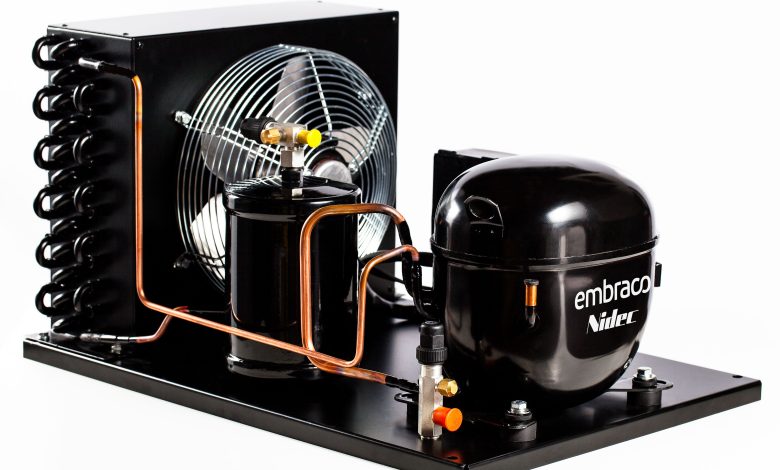The Types and Future of Condensing Units

Introduction to Condensing Units
A condensing units is an essential component of an air conditioning or refrigeration system that is responsible for removing heat from the system. It consists of a compressor, a condenser coil, a fan, and controls. The compressor pumps refrigerant gas into the condenser coil, where it is condensed into a high-pressure liquid. The fan then blows air over the condenser coil to dissipate the heat from the refrigerant.
Condensing units play a crucial role in maintaining the temperature of the refrigeration system, and their proper operation is essential for the overall efficiency of the cooling system. Proper maintenance, including regular cleaning and inspection, can help to prolong the life of the condensing unit and ensure efficient operation.
Types of Condensing Units
There are different types of condensing units available, each designed for specific applications and environments. Some of the common types of condensing units are:
Air-cooled condensing units:
These units are the most common type and are used in most residential and commercial applications. They use a fan to blow air over the condenser coil to dissipate the heat from the refrigerant.
Water-cooled condensing units:
These units use water to dissipate the heat from the refrigerant instead of the air. They are more efficient than air-cooled units but require a water supply, making them more suitable for industrial and large commercial applications.
Remote condensing units:
These units consist of a compressor and condenser coil located in a separate location from the evaporator coil.
Scroll condensing units:
These units use scroll compressors, which are more efficient and quieter than other types of compressors.
Reciprocating condensing units:
These units use reciprocating compressors and are suitable for small to medium-sized applications.
Screw condensing units:
These units use screw compressors and are suitable for large commercial and industrial applications.
The type of condensing unit used in a particular application depends on various factors. Such as cooling requirements, space availability, noise level, and budget.
Components of Condensing Units
Condensing units consist of several components that work together to remove heat from the refrigerant and transfer it to the environment. The main components of a condensing unit are:
Compressor:
The compressor is the heart of the condensing unit and is responsible for compressing the refrigerant gas and pumping it into the condenser coil.
Condenser coil:
The condenser coil is a heat exchanger that receives the high-pressure refrigerant gas from the compressor and removes the heat from it by transferring it to the environment. The coil is usually made of copper or aluminum and has fins to increase its surface area.
Fan:
The fan is located near the condenser coil and is responsible for blowing air over the coil to dissipate the heat from the refrigerant. The fan can be either a propeller or an axial type, depending on the application.
Refrigerant lines:
The refrigerant lines connect the compressor to the condenser coil and the condenser coil to the evaporator coil. They carry the refrigerant gas and liquid between the components.
Expansion valve:
The expansion valve regulates the flow of refrigerant from the high-pressure side to the low-pressure side of the system. It creates a pressure drop, which causes the refrigerant to expand and cool down.
Control devices:
Control devices, such as thermostats and pressure switches, are used to regulate the operation of the condensing unit and ensure that it operates at the required temperature and pressure levels.
Electrical components:
The electrical components, such as capacitors, relays, and contactors, are used to control the power supply to the compressor and fan motor.
These components work together to remove heat from the refrigerant and transfer it to the environment. Creating a cooling effect that is used in various applications, such as air conditioning and refrigeration.
Future of Condensing Units
The future of condensing unit is closely linked to the overall trend toward energy efficiency and sustainability. As energy costs continue to rise and concerns about climate change grow. There is a growing demand for more efficient and environmentally friendly cooling systems.
Some of the potential future developments in condensing unit include:
Use of alternative refrigerants:
Many traditional refrigerants, such as chlorofluorocarbons (CFCs) and hydrochlorofluorocarbons (HCFCs), have been found to have a detrimental impact on the environment. As a result, there is a push toward the use of alternative refrigerants that are more environmentally friendly. Such as hydrofluorocarbons (HFCs), hydrocarbons (HCs), and natural refrigerants.
More efficient compressors:
The development of more efficient compressors, such as variable speed compressors and digital scroll compressors, can greatly improve the energy efficiency of condensing units.
Integration with renewable energy sources:
The integration of condensing unit with renewable energy sources. Such as solar panels and geothermal systems, can greatly reduce the energy consumption and carbon footprint of cooling systems.
Smart technology and control systems:
The use of smart technology and control systems can greatly improve the efficiency of condensing units. By optimizing their operation based on factors such as temperature, humidity, and occupancy.
Improvements in materials and manufacturing:
Advances in materials and manufacturing techniques can result in condensing unit that is lighter, more durable, and more efficient.
Also Read:- How To Choose Top SEO Company In India?
Conclusion
Condensing units are an essential component of cooling systems used in a variety of applications, from residential air conditioning to industrial refrigeration. They work by removing heat from the refrigerant and transferring it to the environment. Creating a cooling effect that is vital for maintaining comfortable and safe living and working conditions.
As the demand for energy efficiency and sustainability grows. The future of condensing unit is likely to be characterized by the use of alternative refrigerants, more efficient compressors, integration with renewable energy sources, smart technology, and control systems, and improvements in materials and manufacturing techniques.
Overall, the continued development and improvement of condensing units will play a crucial role in the meeting. The challenges of providing efficient, sustainable, and reliable cooling systems for a rapidly changing world.



